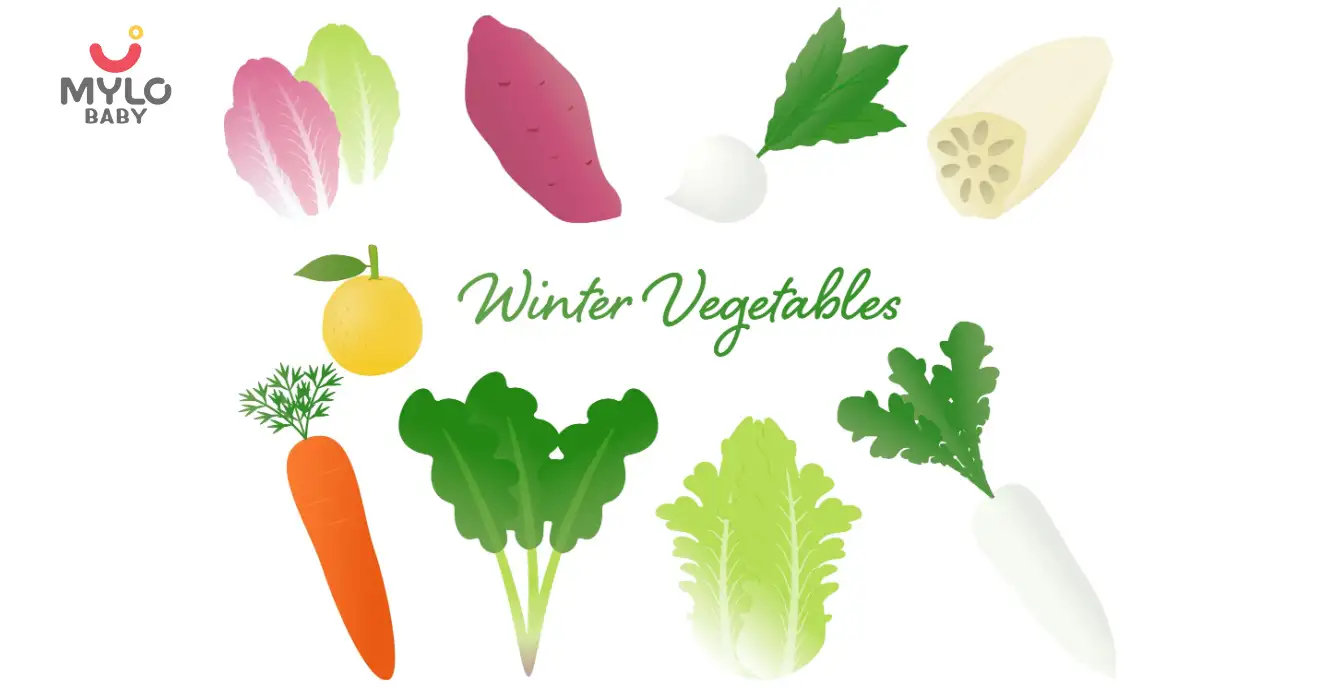Get MYLO APP
Install Mylo app Now and unlock new features
💰 Extra 20% OFF on 1st purchase
🥗 Get Diet Chart for your little one
📈 Track your baby’s growth
👩⚕️ Get daily tips

OR


Article Continues below advertisement
- Home

- The A-Z Guide to Identifying Stem Vegetables for Kids
In this Article
- What are stem vegetables?
- Stem vegetables names
- 1. Asparagus
- 2. Broccoli
- 3. Celery
- 4. Rhubarb
- 5. Kohlrabi
- 6. Bok Choy
- 7. Fennel
- 8. Leeks
- 9. Kohlrabi
- 10. Celeriac
- Stem vegetables chart
- Tips to make learning stem vegetables names easy for kids
- 1. Introduce through food
- 2. Use visual aids
- 3. Read books about vegetables
- 4. Visit a local farm or farmers market
- 5. Cook together
- 6. Play vegetable identification games
- 7. Create a vegetable garden
- Key takeaways
Baby Care
 2019
2019The A-Z Guide to Identifying Stem Vegetables for Kids
Updated on 31 January 2024
Are you a parent looking for creative ways to introduce your kids to the colorful and nutritious world of vegetables? Teaching children about the different types of vegetables can be an exciting and educational experience. In this article, we'll delve into the world of stem vegetables and discover fun and engaging ways to teach your little ones about these healthy and delicious foods.
From crunchy broccoli to vibrant asparagus, we'll explore some common stem vegetables we eat and make learning both entertaining and enriching for your children. So, get ready to embark on a delightful journey of discovery as we unravel the stem vegetables list together!
What are stem vegetables?
Stem vegetables are a unique category of vegetables that are characterized by their edible stems. Unlike other vegetables that are primarily consumed for their leaves or roots, stem veggies offer a variety of textures and flavors. These vegetables are not only delicious but also highly nutritious, making them an excellent addition to a child's diet.
Article continues below advertisment
Stem veggies are plants whose stems are the main edible part. They are an important source of vitamins, minerals, and dietary fiber. They can be found in various forms, such as tender stems, shoots, or even flower buds and are usually low in calories.
Stem vegetables names
Here is a stem vegetables name list along with some interesting facts about each vegetable that can help familiarise kids with these veggies:
1. Asparagus
Asparagus is a popular stem vegetable that is known for its distinctive spear-like shape. It is packed with nutrients and is a good source of vitamins A, C, and K. Asparagus can be enjoyed in various ways, including grilling, roasting, or steaming.
2. Broccoli
Broccoli is a versatile stem vegetable that is loved by kids and adults alike. It is rich in vitamins A, C, and K, as well as fiber. Broccoli can be steamed, stir-fried, or even enjoyed raw in salads.
3. Celery
Celery is a crunchy stem vegetable that is often used as a snack or in salads. It is a good source of vitamins A, C, and K, as well as dietary fiber. Celery can be eaten raw, added to soups, or used as a garnish.
Article continues below advertisment
4. Rhubarb
Rhubarb is a unique stem vegetable that is commonly used in desserts. It has a tart flavor and is often paired with sweet fruits. Rhubarb can be cooked down to make sauces, jams, or pies.
5. Kohlrabi
Kohlrabi is a lesser-known stem vegetable that is part of the cabbage family. It has a mild, sweet flavor and a crisp texture. Kohlrabi can be eaten raw in salads or cooked in stir-fries and soups.
6. Bok Choy
Bok choy is a popular stem vegetable in Asian cuisine. It has a mild, slightly sweet flavor and can be cooked in various ways, including stir-frying, steaming, or adding to soups.
7. Fennel
Fennel is a bulbous stem vegetable that has a licorice-like flavor. It can be eaten raw in salads or cooked in soups, stews, or roasted dishes. Fennel is rich in fiber and vitamins C and K.
8. Leeks
Leeks are a member of the onion family and have a milder flavor. They can be used in a variety of dishes, such as soups, stews, or sautés. Leeks are a good source of vitamins A and K.
Article continues below advertisment
9. Kohlrabi
Kohlrabi is a unique stem vegetable that is part of the cabbage family. It has a mild, sweet flavor and a crisp texture. Kohlrabi can be eaten raw in salads or cooked in stir-fries and soups.
10. Celeriac
Celeriac, also known as celery root, is a root vegetable with a celery-like flavor. It can be cooked and mashed, roasted, or added to soups and stews. Celeriac is a good source of vitamins C and K.
You may also like: The A-Z Guide to Identifying Root Vegetables Names for Kids
Stem vegetables chart
To help kids learn and identify stem vegetables, here are stem vegetables names with pictures. By using visual aids, kids can easily recognize and remember different vegetables. This interactive approach will make learning fun and engaging for kids.
Tips to make learning stem vegetables names easy for kids
Learning the names of stem vegetables can be an exciting and educational experience for kids. Here are seven tips to make the learning process easy and enjoyable:
Article continues below advertisment
1. Introduce through food
Encourage kids to try different stem veggies in their meals. Talk about the vegetables, their taste, and texture. This hands-on approach will make it easier for kids to connect the names of the vegetables with their appearance and taste.
2. Use visual aids
Display a stem vegetables chart in your kitchen or dining area. Point out the different vegetables and their names. You can even create flashcards of stem vegetables names with pictures to help kids memorize their names.
3. Read books about vegetables
There are many children's books available that focus on vegetables and healthy eating. Read these books together with your child and discuss the vegetables mentioned in the stories. This will not only help kids learn the names of the vegetables but also understand their nutritional benefits.
4. Visit a local farm or farmers market
Take your child to a local farm or farmers market and let them explore different types of stem vegetables we eat. Talk to the farmers and ask them to explain the names and characteristics of each vegetable. This hands-on experience will make learning more interactive and memorable.
5. Cook together
Involve your child in the cooking process and let them handle the vegetables. Show them how to wash, peel, and chop different vegetables. As you cook together, talk about the names of the vegetables and their role in the recipe. This practical approach will make the learning experience more meaningful for kids.
Article continues below advertisment
6. Play vegetable identification games
Create a game where you show your child stem vegetables examples, and they have to guess the name of each vegetable. You can also play "I spy" in the supermarket or while cooking, where you give clues about a particular stem vegetable, and your child has to guess which vegetable you are describing.
7. Create a vegetable garden
If you have space in your backyard, create a small vegetable garden with your child. Let them choose and plant different stem vegetables. As the vegetables grow, talk about their names and how to care for them. This hands-on activity will not only teach your child about vegetables but also instill a love for gardening and healthy eating.
You may also like: The A-Z Guide to Identifying Winter Vegetables for Kids
Key takeaways
Learning about stem vegetables can be a fun and educational experience for kids. By introducing them to a variety of vegetables, using visual aids, and engaging in hands-on activities, you can help your child understand and appreciate the importance of these nutritious vegetables. Remember to make the learning process enjoyable and interactive to foster a positive attitude towards healthy eating. So, start exploring the world of veggies with your little ones and watch their knowledge and taste buds grow!
Article continues below advertisment



Written by
Anupama Chadha
Anupama Chadha, born and raised in Delhi is a content writer who has written extensively for industries such as HR, Healthcare, Finance, Retail and Tech.
Read MoreGet baby's diet chart, and growth tips

Related Articles
Understanding RSV And Its Long-Term Impact On Lung Health In Preterm Infants
Preventing Respiratory Syncytial Virus (RSV) In Preemies: Essential Steps For New Parents
How Respiratory Syncytial Virus (RSV) Impacts Premature Babies Differently: What Every Parent Needs To Know
Adverbs: A Comprehensive Guide to help small children learn the usage of adverbs
Related Questions
Hello frnds..still no pain...doctor said head fix nhi hua hai..bt vagina me pain hai aur back pain bhi... anyone having same issues??
739 views
Kon kon c chije aisi hai jo pregnancy mei gas acidity jalan karti hain... Koi btayega plz bcz mujhe aksar khane ke baad hi samagh aata hai ki is chij se gas acidity jalan ho gyi hai. Please share your knowledge
746 views
I am 13 week pregnancy. Anyone having Storione-xt tablet. It better to have morning or night ???
738 views
Hlo to be moms....i hv a query...in my 9.5 wk i feel body joint pain like in ankle, knee, wrist, shoulder, toes....pain intensity is high...i cnt sleep....what should i do pls help....cn i cosult my doc.
746 views
Influenza and boostrix injection kisiko laga hai kya 8 month pregnancy me and q lagta hai ye plz reply me
749 views
Related Topics
RECENTLY PUBLISHED ARTICLES
our most recent articles

Fetal Heartbeat
Can Fetal Heartbeat Disappear and Reappear?
(35,024 Views)

Education
The Ultimate Guide to Teaching Children 20 to 30 Tables
(1,644 Views)

Education
GK Questions for Kids from Nursery to Class 6
(3,738 Views)

Growth & Development
Height and Weight Chart for Boys and Girls in India
(38,790 Views)

Education
The A-Z Guide to Identifying Winter Vegetables for Kids
(1,765 Views)

Diet & Nutrition
Dalia in Pregnancy: A Superfood for the Health of Both Mom and Baby
(31,935 Views)
- 1st Birthday Wishes for Your Little One's Big Day
- The Ultimate Guide to Consuming Litchi During Pregnancy
- Almonds in Pregnancy: Cracking the Nutty Secret to Their Benefits
- Popping the Question: Is It Safe to Indulge in Popcorn in Pregnancy?
- Cherry Fruit in Pregnancy: What Every Expectant Mother Should Know
- The Ultimate Guide to Consuming Pista During Pregnancy
- Sugarcane Juice in Pregnancy: Benefits & Precautions
- The Ultimate Guide to Consuming Mushroom in Pregnancy
- The Ultimate Compilation of GK Questions and Their Answers
- The Ultimate Compilation of 2 Letter Words for Children
- The A-Z Guide to Identifying Root Vegetables Names for Kids
- 11 to 20 Table: A Complete Overview for Children
- Tables 1 to 10: A Complete Overview for Children
- Can Herbal Supplements Boost Your Chances of Getting Pregnant?


AWARDS AND RECOGNITION
Mylo wins Forbes D2C Disruptor award
Mylo wins The Economic Times Promising Brands 2022
AS SEEN IN
















At Mylo, we help young parents raise happy and healthy families with our innovative new-age solutions:
- Mylo Care: Effective and science-backed personal care and wellness solutions for a joyful you.
- Mylo Baby: Science-backed, gentle and effective personal care & hygiene range for your little one.
- Mylo Community: Trusted and empathetic community of 10mn+ parents and experts.
Product Categories
baby carrier | baby soap | baby wipes | stretch marks cream | baby cream | baby shampoo | baby massage oil | baby hair oil | stretch marks oil | baby body wash | baby powder | baby lotion | diaper rash cream | newborn diapers | teether | baby kajal | baby diapers | cloth diapers |








